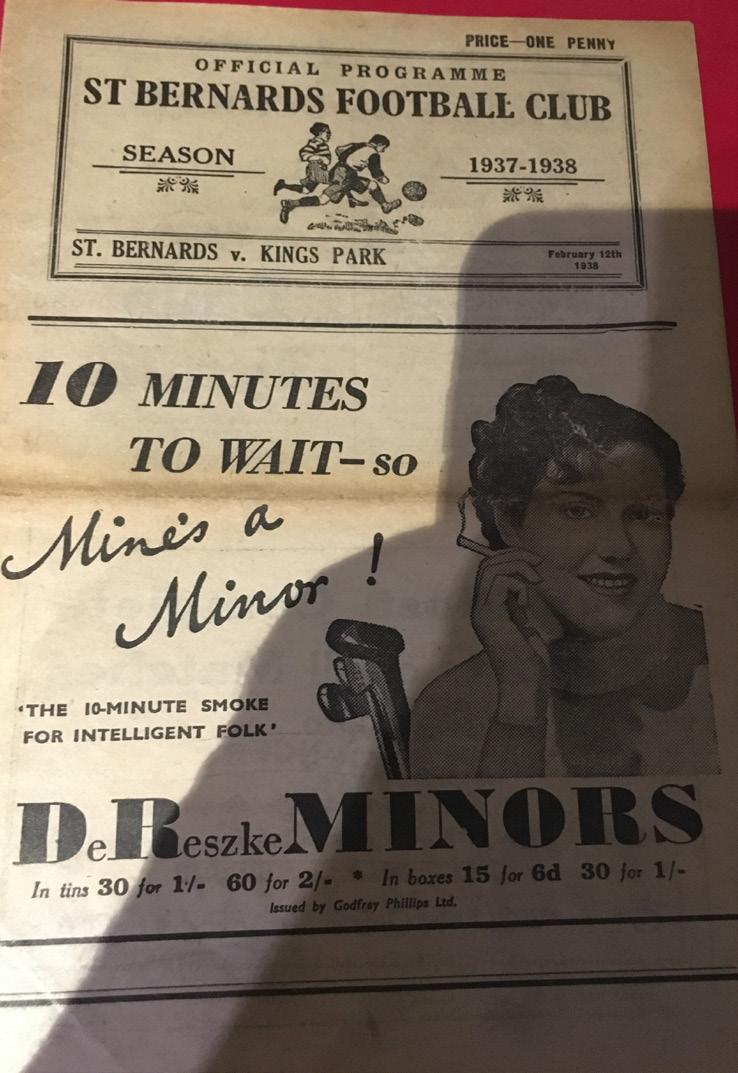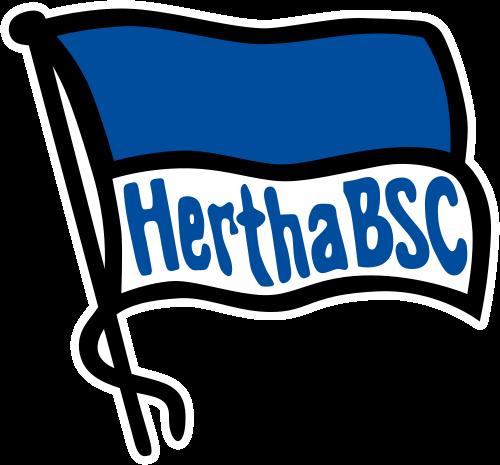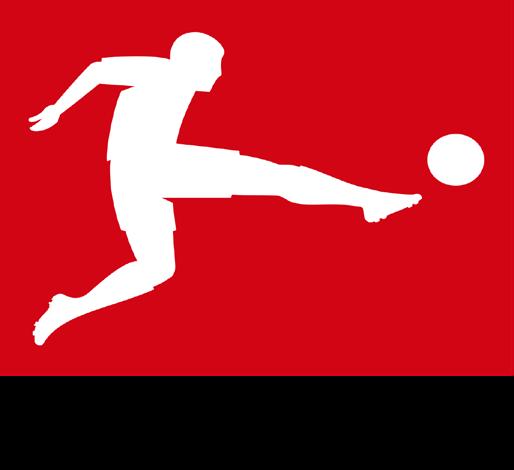
16 minute read
Almondvale Programmes
from The Collector
BRIAN JOHNSON 16 YEARS AT ALMONDVALE PROGRAMMES Brian Johnston is running a successful programme business where his shop on Albion Road, just around the corner from Easter Road Stadium has been flourishing for over 16 years. He reveals how he got into the industry, what it takes to be successful and what he expects to happen for the future of programmes.
He said: “Originally I opened it by pure accident because I got made redundant as the firm I worked for closed down. I’d always been a mad collector. I decided to give it a go and after three years from working at home my wife spotted the shop and told me to move out as the house was getting taken over with all the stuff so the shop has been there for 16 years now.
Advertisement
“Know your market. Know what sells and know your customers. I know I’ll sell 100 Hibs homes so that’s what I take. If I get something rare, I know a hundred guys I could phone up and have it sold in 10 minutes but look after them well.
With the business now going for a considerable length of time, Johnston has needed to adapt and change several things in order for the shop to reach its maximum potential. Online sources have had a big impact with the internet, social media and other sources like eBay pivotal to the changes that need to be made.
Johnson said: “When I first started, I didn’t have a website and the internet hadn’t really got going. I typed everything up on the computer and sent out around 300 paper catalogues.

Over the years that’s changed after getting the website done by a friend of mine and now, I send out around 100-120 catalogues.
“So, it’s gone down two thirds paper wide but the hits on the website are enormous. The sales ratio to catalogues sent out is about 80%, it’s very high because there’s still a lot of people that don’t use online despite what people think.
“People go crazy for match tickets and football cards which 15 years ago nobody bothered about. More memorabilia sell now rather than programmes for the first time ever. It changes all the time.
However, the main bad thing on eBay and other markets where you can buy programmes is that dealers need to look out for fakes, something Johnson has come across a few times over the years.
He said: “You have to know your stuff. There’s a 1947 Victory Cup semi-final between Rangers and Celtic which was copied 30 years ago with old paper but the only thing they couldn’t copy was the staple. There are also about 10 variations of the 1966 World Cup final.”

Going from the past to the future, Johnson is strongly against the idea of online programmes but believes the paper programme is here to stay.
He said: “It’s an absolute farce. People will always buy programmes.
“Clubs in the Lowland League and East of Scotland League sell 30-40 and make a profit at crowds of 80-100 but apparently clubs in the Premier League can’t make a profit.
“There’s no logic to it at all. These clubs need money and it just doesn’t make any sense. I think the problem is the clubs can’t be bothered to do them properly.
Rangers, Hibs and Hearts are big players in the Scottish market for Almondvale Programmes and understanding the market is a huge factor and you must know what buys and sells at different times in order to maximise your profits according to Johnson.
He said: “The marketing has changed for the stuff you sell, and prices fluctuate dramatically. Stuff that would never have sold 10 years ago, there is now a demand for.
“There’s times you have to sell things at, for example every four years you display as much World Cup stuff as you can, and every April, display Champions League stuff as it’s coming up to final time and people will buy them. The Scottish Cup is exactly the same.
That Scottish Cup win by Hibernian brought the club’s matchday programme back to life after a brilliant marketing ploy from the Hibees. Hibs decided to give away a free trading card of each Scottish Cup winning squad member with each programme which was a huge hit with fans.
Johnson commented: “It really boosted programme sales for Hibs. They did 3 sets and have stopped now because the novelty has worn off but that set if very well sought after and there’s nowhere else to go for them. For the younger generation, if you have free giveaways, kids will want them.”

Getting kids involved with programmes is important in expanding the collecting culture with the older generation making up most collectors.
Johnson said: “For the age demographic, 90% are over 40. 50% are over 50.
The period of time is also important for the collecting culture as it strongly dictates what buys and sells: “Stuff that was rare 10 years ago is now more common because of people dying. Stuff that was really rare from the 60’s is now becoming more common because of the age range.
“The time when George Best played for Hibs is hard, and over the next 10 years will become harder but then it’ll change and more will appear on the market again as that’s just a way of life as the generation from that era die off.” From everything Brian has collected over the years, he has a few programmes that standout for various reasons.
He said: “Personally, 1991 League Cup final because it was the last game I went to with my Dad. 2016 because we won the cup at last.
“I have a lot of weird and wonderful stuff that I like, like Leith Athletic and St Bernards, 1939 Scottish Cup semi between Hibs and Clyde which is quite rare. Unique ones like Napoli v Hibs which nobody else has seen.
Almondvale Programmes has saw some great times over the years, but nothing beats the simple things that happen in the business. Johnson added: “The best part of my business is someone walking in the door with a collection because they could have anything. I love old programmes. It’s endless.”



BSC GLASGOW MICHAEL PARK - THE MASTERMIND BEHIND BSC MEDIA AND POCKET PROGRAMME
BSC Glasgow have been through one of the most exciting spells the club has ever experienced since the turn of the year. A run to the fifth round of the William Hill Scottish Cup which set up a tie with Premiership giants Hibernian, as well as an enthralling run in the Lowland League.
Media and Communications Manager of BSC Glasgow, Michael Park has been at the centre of it all. He said: “It’s been really fun! We’ve obviously had our eyes opened to a different level of the game and it’s been a really exhausting journey for us on the staff but the positive momentum it’s generated off the field has been great.”

That positive momentum off the field has saw a huge rise on the club’s social media channels, something Park has been the mastermind of as his eye-catching graphics and other ideas to promote the club have received their wellearned recognition.
He added: “The club’s improvement on social media has been really good. We’ve seen a rise in follower numbers by over 2,000 and we’re regularly hitting a million impressions on our posts. It’s not just there either, on the day of the match against Hibs we had 14,000 hits on the website.”
For the match against Hibernian, BSC produced a pocket-sized programme that fits into the palm of your hand, packed with interesting content about the club’s rise, the manager, board, tea-lady and kitman’s thoughts, all published in a beautiful 40-page publication.
Park said: “People have loved it – we’ve been delighted with the reception, and Hibs seemed interested in it!
“It was something we’d heard about clubs on the continent doing and we liked the idea. A5 programmes are nice but they’re generally expensive to print and often to fill too. We wanted something that people could just slip in their pocket and go.
“We tend to only print them for matches where we believe there will be a large crowd.”
A large crowd was exactly what BSC got when they welcomed the Hibees the to Indodrill Stadium in Alloa, with 2,120 supporters packed into the ground. This was something the club had never experienced before and brought a new set of challenges for BSC, including a brand new ticketing system which shows the progress the club has made since they were formed as a senior side in 2014. Park said: “We’ve come on leaps and bounds on and off the field. One of the first things I wanted to do when I started was stamp a brand identity on the club and we’re seeing that come to fruition now thanks to hard work from all of the staff at the club. “On the field things have just been improving every season since Stephen Swift joined us. He’s an exceptional manager and he’s destined for big things in the game.” BSC’s stand-out social media presence is clear to see and Park reveals his secrets to the success. He said: “It’s trial and error mostly. I look around at what big sports brands are doing and see what we could potentially do to work towards something similar. “We like to do things in our own way though, but there’s no harm in looking at different sports with huge budgets to see what they think is the right way to do things. “Listening to feedback is important too, there’s a lot of people who have a lot to offer in terms of their opinions on the work you do so taking that on board helps a lot.” On the field, Stephen Swift’s men currently sit fourth in the Lowland League table, but with games in hand against teams around them, a title shot is not out of the equation. For those big games, we can expect a couple more pocket-sized programmes from BSC, although Park is unsure if it is a template that will remain in the game in the future.
He said: “A lot of clubs have their ways of doing things and I wouldn’t like to think that we’re a club people would be seeking to emulate but programmes are a tough one for clubs. I think we’ll probably see a move towards paperless programmes before anyone runs off and starts printing pocket programmes.”
The club love to do things different and come up with exciting concepts, but Park does not want to reveal too much about what they have planned.
He added: “That would be telling. We’ve got a few ideas for next season to build on this one, but a lot depends on the next few months on the park and off. We’ll see!”


Some of Michael’s eye-catching social media output. Goal graphics and funny match-day graphics including Navid from Still Game after he was spotted in the crowd against Hibs

CLASSICAL PROGRAMME
A different angle on the Hillsbrough disaster of 1989 where 96 Liverpool fans tragically lost their lives.
This article looks at ‘The Terrible Irony’ of the matchday programme from the horrible day that still means so much to so many people.


The first word that comes to mind for this pro- gramme is irony – a terrible irony.
The 15th of April 1989 remains the UK’s worst sporting disaster.
A ‘carnival atmosphere’ was originally what Hillsbrough saw as Liverpool took on Notting- ham Forest in the FA Cup semi-final but the large crowd of Liverpool fans in the Leppings Lane end behind the goal created disaster as the turnstiles couldn’t cope with the volumes of Reds fans waiting to get in. All of them had valid tickets contrary to the cruel lies that were put about at the time and were then perceived as the ‘truth’ for many years.
The fatal crush took place in the two middle pens as 96 fans lost their lives, the oldest aged 67 and the youngest only 10 years old.
However, away from the fatal disaster is the matchday programme that provides a terrible irony and the photo content inside tells a fear- some tale given what happened.
The ‘Welcome Back’ page written by Sheffield Wednesday Chairman Mr H. E. McGee features Leppings Lane on the background of his article with one paragraph of his section labelled as ‘Perfect Venue’ which gives that spooky aura to the programme after the events that unfolded.
He states that: “preparation beforehand is of par- amount importance” for the venue, which sadly, was not properly carried out.
The matchday programme is supposed to rep- resent a physical keepsake for your footballing memory. However, this one is a terrible reminder of an awful tragedy that remains profound in people’s hearts and the Justice For The 96 cam- paigns we’ve seen around the footballing globe show exactly how much it means.



EDITOR’S PICK


2 1
The Match
I decided to pick the programme for this game as it was the first match I attended in a foreign country as part of a weekend break to Berlin last year.
After making it to the ground in plenty time, stopping for (another) currywurst outside the ground, if you haven’t had one of them before, get one!
But I needed to get a locker to store a bag that was too big to get into the stadium which resulted in missing the first 10-15 minutes of the game. Safe to say I didn’t miss much.
The first half was dreadful. The highlight was someone coming around the stadium with a huge jug of beer offering out pints. You certainly don’t get that in Scotland.
The tactics and cautious approach from both teams was a lot different than the brand of football we see in Scotland with chances for wing backs to bomb on, but they didn’t take the opportunities to do so.
Expecting the second half to be a big improvement, it kicked into life as soon as the referee blew his whistle. Hertha’s stand out defender Niklas Stark turned the ball into his own net within 60 seconds of the restart.
But four minutes later, Liverpool loanee Marko Grujic found the back of the net from close range. This didn’t stop the travelling Mainz fans from singing or bouncing.
But 10 minutes later, Hertha took the lead and Stark made up for his error at the other end by firing into the net after Mainz failed to properly clear a corner and that turned out to be the winning goal.
The Programme
A small pocket-sized programme that folds out into a large poster that was given out free of charge.
Cover picture shows Hertha celebrating in their last home match when they took the lead against Werder Bremen, although the visitors equalised in added time to snatch a 1-1 draw.
One stand-out page is the ‘Direktes Duell’ (di- rect duel) between Hertha defender Niklas Stark and Mainz centre back Stefan Bell. The page compares the two players age, height, position, appearances, duels won and pass accuracy.
There is also a page comparing the two team’s season so far. It details the club’s league position and points, goals for and against, cards (where Hertha had 44 yellows and 1 red compared to Mainz’s 42 yellows and 0 reds.
Top scorers, which at the time was Ondrej Duda with 10 for Hertha and Jean-Phillipe Mateta with 7 for the visitors. It also compared the top assists for the two teams. These were David Selke with 5 for the hosts and right back Daniel Brosinski also with 5 for the 05ers.
The programme folds out into 9 different sec- tions on the poster, with 2 adverts which are Hertha’s main sponsor Tedi and kit manufactur- ers Nike.

Ultimately, a pocket size souvenir given away free of charge can’t be complained with, espe- cially if you paid more for a bigger publication and can’t speak a word of German to read any- thing in it!



How the season went for both teams
A proper mid-table clash at the beginning of March saw neither side properly kick-on.
Both teams ended the campaign on 43 points with Hertha in 11th and Mainz ending 12th.
Hertha reached the last 16 of the DFB-Pokal before losing out to Bayern Munich 3-2 after extra time.
Mainz also lost the exact same way, but in round 2 away to Augsburg.
Bosnian striker Vedad Ibisevic was Berlin’s top scorer with 11 goals across all competitions with Jean-Phillipe Mateta bagging 14 for the 05ers. Hertha Berlin: Jarstien, Stark, Lustenberger, Torunarigha, Lazaro, Mittlestadt, Grujic, Maier, Duda (Baak 90), Kalou (Leckie 77), Selke (Ibisevic 67).
Mainz: Muller, Donati (Kunde 87), Martin, Bell, Niakhate, Gbamin, Oztunali, Latza (Maxim 79), Quaison, Onisiwo (Mateta 65), Ujah.
Attendance: 33,981






